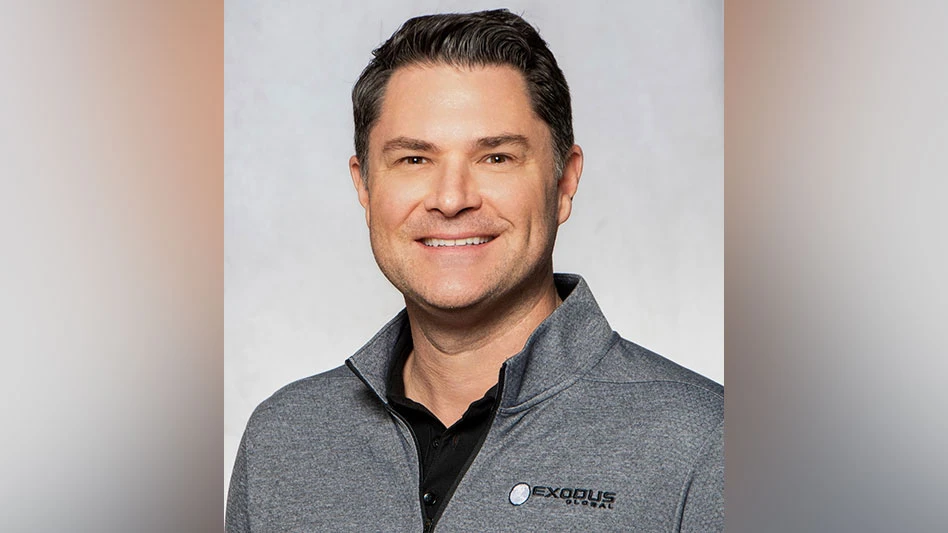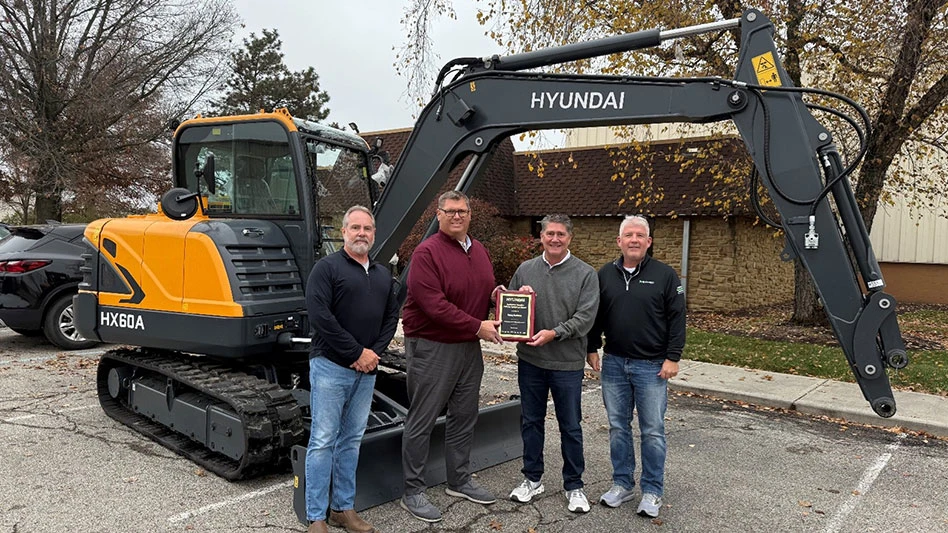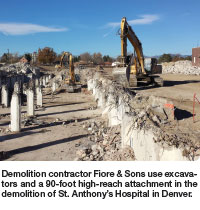 When 19 acres of land and more than 1 million square feet of buildings in the middle of a major city become vacant after more than a century of use, it is going to leave a significant void. But thanks to the vision of a developer and some big plans, a former hospital site in Denver is undergoing a major transformation.
When 19 acres of land and more than 1 million square feet of buildings in the middle of a major city become vacant after more than a century of use, it is going to leave a significant void. But thanks to the vision of a developer and some big plans, a former hospital site in Denver is undergoing a major transformation.
St. Anthony Hospital had provided health care services in western Denver since the 1880s. At its peak it had more than 300 beds and employed 2,000 people. The hospital underwent expansions nearly every decade of its existence, until finally it was closed for good in 2009. The St. Anthony Central Hospital Campus moved to a new location in Lakewood, Colo., leaving the property vacant.
EFG-South Sloan’s Lake I LLC, a subsidiary of the brownfield development company EnviroFinance Group LLC (EFG), acquired the site in January 2013. According to Cameron Bertron, EFG project manager and senior vice president, the site was an obvious fit for the company. “We look for sites that have become vacant holes in the urban fabric and put them back into productive use,” he explains.
Bertron is overseeing all aspects of the St. Anthony Hospital project from the acquisition to the abatement and demolition, to the site planning, infrastructure installation and back-end land sales. EFG does most of its business in Colorado, California and the mid-Atlantic. Bertron describes what the company does as “land recycling.”
Bertron recalls of St. Anthony Hospital, “It was a lot of building to take down and a building with a lot of history. It represented a unique opportunity to both dismantle a building and see how much of it we could recycle, reuse and repurpose on-site and then hopefully integrate the fabric of the old neighborhood back together.”
Over the years, the neighborhood developed around the hospital and the hospital started to expand into the neighborhood. While Bertron says the hospital provided fabulous health care amenities, it also created a big hole, seven blocks in all, that was impenetrable to pedestrians, bikes and cars.
“Our first move was to demolish that building and bring the pedestrian and street grids back through the site and reconnect the neighborhood.”
EFG also expects the site’s mixed-use designation will allow at least some of the jobs that were lost when the hospital moved out of the neighborhood to be recovered.
Because EFG specializes in environmental remediation and abatement, land use planning and investment capital, “it makes for a pretty good fit when it comes to big infill sites like St. Anthony’s,” says Bertron.
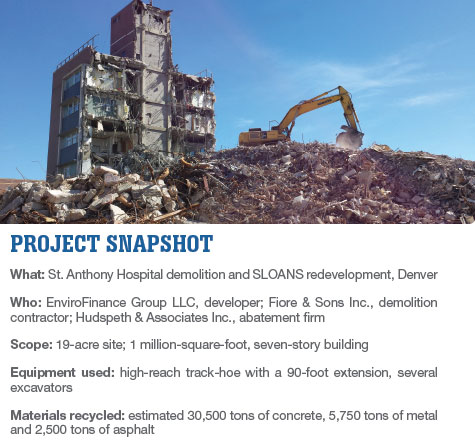
An experienced team
In order to make way for the new site plans, demolition had to occur. “There was a great deal of abatement that had to go on in that building,” says Bertron. “It was a 12-phase abatement and demolition permit with the state of Colorado because there were so many eras of construction on the site.”
Denver-based demolition firm Fiore & Sons and Colorado-based abatement contractor Hudspeth & Associates Inc. coordinated on the project.
“I think they developed a really smart, unique approach. They sat down with the regulators early, walked through all the data and information we had on the building,” recalls Bertron.
The demolition team shared data with regulators on building material, asbestos and the medical history of the building. A central plant contained underground tanks, generators and boilers.
“They were a largely self-sustaining facility,” explains Bertron of the site. “They even had ground water and their own potable water system.”
He adds, “What Fiore and Hudspeth were able to do that I think was particularly beneficial was to break the building up into 12 different components and get a phase abatement sign-off on a single demolition permit.”
This meant Hudspeth could abate and get clearance on a particular piece of the hospital, and Fiore & Sons could come in behind them and start demolishing one portion of the building while Hudspeth was working at a different part of the building.
Trent Nelson, project manager for Fiore & Sons, says the 12 phases “allowed us to abate and sign off the building in sections. This allowed us to begin demolition on certain areas in the building, while abatement operation was still in progress in other areas of the building.”
Nelson says Fiore & Sons coordinated with Hudspeth through daily scheduling meetings and communication.
Bertron describes it this way, “Fiore sort of followed Hudspeth around the building, and we didn’t have to wait for Hudspeth to abate and get clearance on a million square feet of building before Fiore could even start. As a result we made that building go away in a shorter period of time.”
Finding a balance
The site consisted of nearly 1 million square feet of structures to demolish. To accomplish the demolition, Fiore & Sons used a 90-foot high-reach attachment to “chew away the floors of the building one bite at a time,” says Rick Givan, manager, special projects, Fiore & Sons.
According to Givan, when demolishing an old hospital, “You never know what you are going to encounter.” The unknown variables could be anything from lead-lined walls to biohazards. Workers wore protective suits and air masks as a precaution.
Underground demolition included building foundation, tunnels and existing utilities. Nelson says, “We approached this by reviewing old as-built drawings of the property, and through this review we were able to identify the existing utility locations, tunnels and extent of foundations.”
Fiore & Sons estimates that when the demolition is complete at the end of 2013, it will have recycled 30,500 tons of concrete, 5,750 tons of metal and 2,500 tons of asphalt.
Bertron says it is tricky to find the balance between reclaiming as much of the building as possible and knowing when to draw the line on when something should be removed as waste versus salvaged for reuse.
“I have to say I have been very impressed with both Fiore and Hudspeth as we’ve worked through those decisions with them,” says Bertron. “We’ve ended up with thousands of tons of material that we could reclaim and repurpose and been very smart about what we’ve chosen to remove from the site and dispose of.”
EFG hired Fiore & Sons six months ahead of the demolition and gave the company free access of the building. This allowed the firm to think through the smartest way to take the building down. “Fiore and Hudspeth have had a remarkably incident-free project with few if any surprises,” remarks Bertron. “I think part of that is that they had a lot of lead time to figure out the best way to take a building down.”
Bertron continues, “We think the earlier and the smarter, the better, in terms of engaging remediation and demolition contractors. It is an information game and surprises aren’t good for anybody.”
Bertron says EFG selected Fiore & Sons for the project because it is a local contractor that has been in business for a few generations and had the knowledge of handling large structures in urban neighborhoods.
“We knew that was going to mean a lot of dust control and a lot of trucks coming in and out of the neighborhood. We felt Fiore had the experience to do that and do that well,” Bertron says. He adds that Fiore & Sons also did a good job of securing the site, noting that EFG closed on the site Jan. 11, 2013 and by Jan. 18, Fiore & Sons had the entire site fenced off and a security system in place.
New development
Much of the concrete that Fiore has been able to recycle on-site will be reused to build the infrastructure and for block development. Some elements of the hospital will be salvaged including the stone and metal work, which will be repurposed into the landscape of the new development to provide a connection to the site’s past. The chapel will be preserved and the nurses’ convent may be converted into a boutique hotel. A 700-car garage is also staying on the site.
Bertron says four blocks of what EFG calls “the new sustainable urban neighborhood on the south shore of Denver’s Sloan’s Lake Park – SLOANS,” is under contract or in contract negotiations. Retail, office, restaurants and apartments are included in those plans. The site will be a Leadership in Energy and Environmental Design Neighborhood Development (LEED ND).
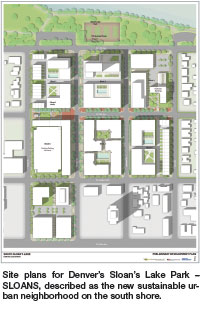 LEED ND project indicators include use of recycled material in the infrastructure as well as using environmentally friendly materials, according to Bertron. The site also will reduce the demand on the stormwater system because runoff will be diverted into planting beds in the streetscape. A special improvement district (SID) will assist builders wanting to use renewable energy.
LEED ND project indicators include use of recycled material in the infrastructure as well as using environmentally friendly materials, according to Bertron. The site also will reduce the demand on the stormwater system because runoff will be diverted into planting beds in the streetscape. A special improvement district (SID) will assist builders wanting to use renewable energy.
“As a site developer, it is about laying a site foundation that makes it more efficient, more desirable for vertical developers to create sustainable outcomes,” explains Bertron. “By being a LEED ND site, we make it easier for a vertical developer to go for a LEED rating on a building because they get credit for all the work we put into the site.”
The site is near a park and a lake with desirable views of the mountains and downtown, according to Bertron. “It is a great real estate opportunity once we get that building out of the way,” he says, referring to the hospital.
“I think that when a site has been providing health care to a community for 130 years and then to see that go away has been very difficult for this neighborhood,” summarizes Bertron. “But, I think we have been successful in working with the community to identify plans for reuse that not only embrace much of what the community cares about, but also catalyzes reinvestment in an area that has been historically underutilized. I think that our project will be a real Renaissance for the west side of Denver.”
The author is managing editor of Construction & Demolition Recycling and can be contacted at ksmith@gie.net.
Watch a video of the demolition at CDRecycler.com/st-anthony-video.aspx.
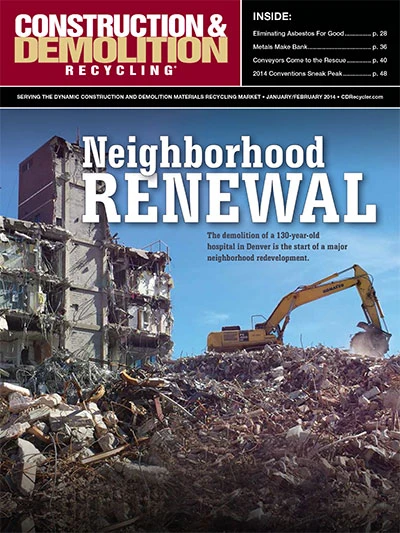
Explore the January 2014 Issue
Check out more from this issue and find your next story to read.
Latest from Construction & Demolition Recycling
- Sun Equipment launches used construction equipment division serving Houston
- Harbor Logistics adds business development executive
- Terex Ecotec announces Blue Machinery as distributor
- SA Recycling completes FPT facilities purchase
- Alamo Group acquires loading equipment maker
- Develon to spotlight compact equipment at ConExpo
- Construction job openings remain low in October
- Sysdyne acquires Slabstack, expanding construction materials reach
